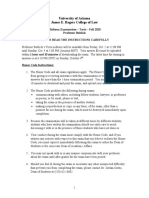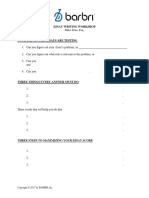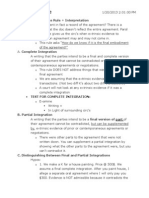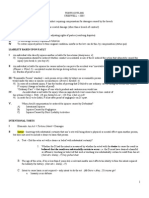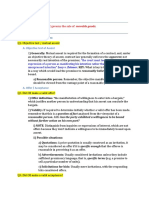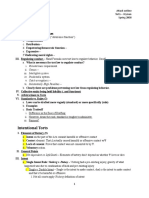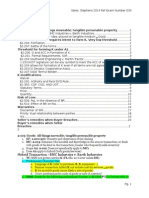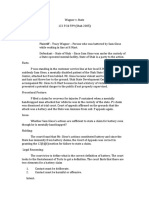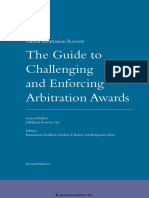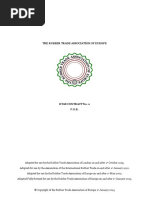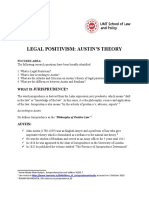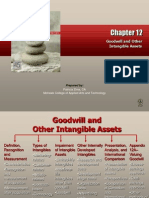Torts Essay 1
Torts Essay 1
Uploaded by
Zviagin & CoCopyright:
Available Formats
Torts Essay 1
Torts Essay 1
Uploaded by
Zviagin & CoOriginal Description:
Copyright
Available Formats
Share this document
Did you find this document useful?
Is this content inappropriate?
Copyright:
Available Formats
Torts Essay 1
Torts Essay 1
Uploaded by
Zviagin & CoCopyright:
Available Formats
TORTS
QUESTION 1
Homeowner kept a handgun on his bedside table in order to protect himself against
intruders. A statute provides that “all firearms must be stored in a secure container that is
fully enclosed and locked.” Burglar broke into Homeowner’s house while Homeowner was
out and stole the handgun.
Burglar subsequently used the handgun in an attack on Patron in a parking lot belonging to
Cinema. Patron had just exited Cinema around midnight after viewing a late movie. During
the attack, Burglar approached Patron and demanded that she hand over her purse. Patron
refused. Burglar drew the handgun, pointed it at Patron, and stated, “You made me mad, so
now I’m going to shoot you.”
Patron fainted out of shock and suffered a concussion. Burglar took her purse and fled, but
was later apprehended by the police. Cinema had been aware of several previous attacks
on its customers in the parking lot at night during the past several years, but provided no
lighting or security guard.
Under what theory or theories, if any, might Patron bring an action for damages against
Homeowner, Burglar, or Cinema? Discuss.
CA 13 et torts U.indd 13 1/8/2021 12:45:00 PM
ANSWER TO QUESTION 1
PATRON V. HOMEOWNER—NEGLIGENCE
To prevail in a negligence action, Patron must show that (i) Homeowner owed her a duty of care,
(ii) Homeowner breached that duty, (iii) the breach of duty was the actual cause and the proximate
cause of the harm, and (iv) Patron suffered damages.
Duty of Care Owed to Foreseeable Plaintiff
A general duty of care to act as a reasonably prudent person is owed to all foreseeable plaintiffs. If
the defendant’s conduct creates an unreasonable risk of injury to persons in the position of the plain-
tiff, the general duty of care extends from the defendant to the plaintiff. Under the majority (Cardozo)
view, the plaintiff must be within the foreseeable zone of danger from the defendant’s activity to be
owed a duty of care. Under the minority (Andrews) view, the duty of care is owed to anyone.
Here, Homeowner kept his handgun out on a bedside table. Accordingly, he owed a duty of care
to anyone who might be at risk of injury from the gun because it was not secured. Under the
majority approach, Patron would have to establish that she was in the zone of danger from the
unsecured gun. This may be difficult because the gun was taken by a thief and Patron was not on
Homeowner’s premises when it was used against her. Nevertheless, a court could find that leaving
the gun unsecured on a bedside table where it could be stolen created a foreseeable risk of injury
to any victims of the thief, such as Patron.
Relevant Standard of Care—Application of Statute
The general standard of care is that of a reasonably prudent person under the same or similar
circumstances. Under this standard, Homeowner would need to act as a reasonably prudent
handgun owner in storing a gun in his home.
Alternatively, the standard of care in a common law negligence case may be established by
proving the applicability to that case of a statute providing for a criminal penalty. If that is done,
a specific duty imposed by the statute will replace the general common law duty of care. For
the statutory standard to apply, the plaintiff must show that (i) she is in the class intended to be
protected by the statute, and (ii) the statute was intended to prevent the type of harm that the
plaintiff suffered.
Here, the statute imposed a specific duty that all firearms were to be stored in a secure container
that is fully enclosed and locked. Homeowner would argue that the class of persons intended to
be protected by the statute is limited to persons residing in or visiting Homeowner’s home, and
that the statute was intended to protect those persons, in particular children, from accidentally
shooting themselves or someone else with the gun. On the other hand, Patron would argue that the
statute was intended to protect anyone against whom the gun was used without permission of the
owner, and that class includes victims of a thief of the gun. Patron would also argue that the harm
intended to be prevented was not just from being shot but also from normal reactions to being
threatened by the gun, such as fainting and injuries caused as a result. Because the facts do not
indicate the intent of the legislature in enacting the statute, it is not clear whether Patron will be
able to rely on the statute to establish the standard of care.
Breach of Duty
When the defendant’s conduct falls below the level required by the applicable standard of care,
he has breached his duty. If a statutory standard of care applies, most courts consider violation
CA 13 et torts U.indd 14 1/8/2021 12:45:00 PM
TORTS
of the statute as “negligence per se,” i.e., a conclusive presumption of duty and breach of duty. A
minority of courts hold that the violation is only either (i) a rebuttable presumption as to duty and
breach, or (ii) prima facie evidence of negligence.
Even if Patron cannot rely on violation of the statute to establish breach of duty, she has a strong
argument that a reasonably prudent handgun owner would store his gun in a safe place so that no
one other than the owner would have access to it. While Homeowner might argue that locking
the gun up would make it harder to grab in an emergency, the existence of the statute indicates
that the legislature believed the risk is greater from leaving the gun out where anyone could get it,
including an intruder. Given the minimal burden on Homeowner of securing or hiding his gun, it
is likely that Homeowner’s failure to do so breached his common law duty of due care.
Actual Cause
The defendant’s conduct is the actual cause of the plaintiff’s injury if the injury would not have
occurred but for the defendant’s conduct. Here, but for Homeowner’s failure to store the gun
in a secure locked container, Burglar would not have stolen the gun and used it against Patron.
Furthermore, Homeowner’s conduct clearly was a substantial factor in bringing about Patron’s
injury. Hence, it is likely that Homeowner’s conduct will be deemed a cause in fact of Patron’s
injury.
Proximate Cause
In addition to being the actual cause, the defendant’s conduct must also be the proximate cause
of the injury. The general rule of proximate cause is that the defendant is liable for all harmful
results that are the normal incidents of, and within the increased risk caused by, his conduct. In
an indirect cause case, an intervening force comes into motion after the defendant’s negligent
conduct and combines with it to cause the plaintiff’s injury. If the defendant’s negligence created a
foreseeable risk that this intervening force would harm the plaintiff, the defendant is liable for the
harm caused. Under this rule, if the defendant’s negligence created a foreseeable risk that a third
person would commit a crime or intentional tort, the defendant’s liability will not be cut off by the
crime or tort. On the other hand, if the crime or tort is not foreseeable, it will be deemed a super-
seding force and cut off the defendant’s liability for the harm.
Here, Homeowner will contend that it is not foreseeable that his leaving the gun out would result
in Patron’s injury at the Cinema parking lot, and that the criminal actions of Burglar constituted
a superseding intervening force. On the other hand, Patron will argue that it was foreseeable that
someone would steal Homeowner’s unsecured gun and use it in a crime against someone else. The
fact that Homeowner kept a gun on his bedside table to protect himself against intruders suggests
that Homeowner was aware of a risk of a break-in. Someone breaking into his home is very likely
to steal a gun that is left out on a table, and it is foreseeable that such a person will use the gun
in an attempt to steal from another person. Hence, Burglar’s conduct probably will not cut off
Homeowner’s liability for his negligent conduct.
Damages
A plaintiff is entitled to be compensated from the tortfeasor for all her damages, even if the extent
or severity of the harm is unforeseeable (i.e., the tortfeasor takes his victim as he finds her). Here,
Patron suffered a concussion after fainting from the shock of being threatened with a gun. This
constitutes recoverable damages and completes Patron’s prima facie case.
Defenses—Conduct of Patron
A plaintiff in a negligence case is also held to a standard of reasonable care. At common law, a
plaintiff whose negligence was found to have contributed to her injury was completely barred
CA 13 et torts U.indd 15 1/8/2021 12:45:00 PM
from recovering under traditional contributory negligence rules. Similarly, a plaintiff who
knowingly and voluntarily assumed the risk of injury from the defendant’s conduct, whether
expressly or impliedly, was barred from recovering damages. Now, most states have replaced the
traditional contributory negligence and implied assumption of risk rules with a comparative negli-
gence system, in which the trier of fact weighs the plaintiff’s negligence against that of the defen-
dant and reduces the plaintiff’s damages accordingly. In a pure comparative negligence system,
the plaintiff may recover some damages no matter how much at fault she is. In a partial compara-
tive negligence system, the plaintiff may not recover any damages if her negligence rises above a
threshold level.
Here, Homeowner could argue that Patron was contributorily negligent by walking to her car late
at night, apparently by herself, and that Patron assumed the risk of injury by refusing to hand over
her purse to Burglar when confronted by him. Patron will respond that her conduct was not unrea-
sonable. There was no security guard to escort her to her car and nothing suggests that she was
aware of the previous attacks on Cinema customers. Furthermore, Burglar did not draw the gun
until after Patron refused to give him her purse. Nothing indicates that she was aware that he had
a gun when he first demanded the purse, so it is not likely that she will be deemed to have volun-
tarily assumed the risk of being threatened with a gun.
In conclusion, it is a close question whether Homeowner will be deemed to owe a duty to Patron.
If such a duty is found, Patron is likely to prevail in her negligence action against Homeowner.
PATRON V. BURGLAR
Assault
To establish a prima facie case for assault, the plaintiff must show (i) an act by the defendant
creating a reasonable apprehension in the plaintiff of immediate harmful or offensive contact
to the plaintiff’s person, (ii) intent by the defendant to bring about such apprehension, and (iii)
causation. Here, Burglar drew a handgun, pointed it at Patron, and told her that he was going to
shoot her. His act caused Patron a reasonable apprehension of imminent harm, and his act was
intentional. Hence, he would be liable for the tort of assault. While Patron does not need to show
damages to satisfy the prima facie case, she can recover damages from the injury she suffered
from fainting, because her fainting was caused by the assault.
Battery
To establish a prima facie case for battery, the plaintiff must show (i) an act by the defendant that
brings about harmful or offensive contact to the plaintiff’s person, (ii) intent by the defendant to
bring about such contact, and (iii) causation. For purposes of battery, anything connected to the
plaintiff’s person is viewed as part of the plaintiff’s person. Furthermore, a person may recover for
battery even though she is not conscious of the harmful or offensive contact. Here, Patron’s injury
from fainting was caused by the assault, but she also may have suffered offensive contact when
her purse was taken. The facts do not specify, but Patron may have still had her purse in her hands
or on her shoulder when she fainted. If so, Burglar intentionally committed an offensive contact
when he took the purse from her person and therefore would be liable for battery.
False Imprisonment
To establish a prima facie case for false imprisonment, the plaintiff must show (i) an act or
omission by the defendant that confines or restrains the plaintiff to a bounded area, (ii) intent on
the defendant’s part to confine or restrain the plaintiff, and (iii) causation. False imprisonment
may be accomplished by a threat of force against the plaintiff, and it is immaterial, except as to
CA 13 et torts U.indd 16 1/8/2021 12:45:00 PM
TORTS
the extent of damages, how short the time period of the restraint was. Here, Patron was restrained
by Burglar’s demand that she hand over her purse in conjunction with his drawing a gun on her.
She was restrained from fleeing because of the threat of force, and Burglar intended to restrain
her until he could acquire her purse. Hence, Burglar is liable to Patron for false imprisonment.
Intentional Infliction of Emotional Distress
A prima facie case for intentional infliction of emotional distress requires the following elements:
(i) an act by the defendant amounting to extreme and outrageous conduct; (ii) intent by the defen-
dant to cause the plaintiff to suffer severe emotional distress, or recklessness as to the effect of the
defendant’s conduct; (iii) causation; and (iv) damages—severe emotional distress. Here, Burglar’s
act of pulling out a gun and telling Patron that he is going to shoot her is extreme and outrageous
conduct. It appears that he intended to cause her to suffer severe distress because he was angry at
her refusal to give him the purse; even if his intent is not established, it is clear that he recklessly
disregarded the high likelihood that she would suffer severe distress from being threatened with
a gun. His act caused her to suffer such severe distress that she fainted out of shock. She could
further establish by her own testimony that she suffered severe distress from Burglar’s conduct.
Burglar therefore will be liable to Patron for intentional infliction of emotional distress.
Trespass to Chattels
As to the purse and its contents, the issue is whether Burglar will be liable for conversion or only
trespass to chattels. The elements of trespass to chattels are (i) an act by the defendant that inter-
feres with the plaintiff’s right of possession in the chattel, (ii) intent to do the act that brings about
the interference, (iii) causation, and (iv) damages. While actual damages are required, the loss of
possession itself is deemed to be an actual harm. If the interference with the chattel is so serious
in nature or in consequences as to amount to a claim of dominion over the chattel, the interference
will constitute a conversion. Here, Burglar intended to rob Patron of her purse and its contents,
and he did so once she had fainted. Patron was dispossessed of the purse and its contents, satis-
fying the damage element. As discussed below, however, Burglar’s conduct was sufficiently
serious in nature as to constitute a conversion.
Conversion
To prove a prima facie case of conversion, the plaintiff must show (i) an act by the defendant
interfering with the plaintiff’s right of possession in the chattel that is serious enough in nature or
consequence to warrant that the defendant pay the full value of the chattel, (ii) intent to do the act
that brings about the interference with the plaintiff’s right of possession, and (iii) causation. As
stated above, Burglar intended to rob Patron of her purse and its contents, and he did so once she
had fainted. Burglar’s conduct in dispossessing Patron of her property during an armed robbery
was sufficiently serious in nature as to constitute a conversion, regardless of whether she got her
purse or its contents back when he was apprehended by the police. Patron’s remedy for conversion
will be either damages for the fair market value of the chattel or replevin of the property.
Defenses
Burglar has no defenses to any of the intentional torts discussed above.
PATRON V. CINEMA—NEGLIGENCE
Duty of Care
Under the rules stated above, Patron was a foreseeable plaintiff because she was in Cinema’s
parking lot, and therefore in the zone of danger from any condition of or activity on Cinema’s
property.
CA 13 et torts U.indd 17 1/8/2021 12:45:00 PM
Relevant Standard of Care—Business Invitee
One who enters onto property for a purpose connected to the business of the property owner is
an invitee. The property owner owes an invitee a duty to use reasonable care to keep the property
reasonably safe for the benefit of the invitee, which includes making reasonable inspections.
Specifically, the property owner has a duty to warn of or make safe nonobvious dangerous condi-
tions on the premises and to use ordinary care in the conduct of active operations on the property.
Furthermore, businesses that gather the public for profit on their premises have a duty to use
reasonable care to prevent injury to their patrons from third persons. Here, Cinema operates a
business on its property and Patron was an invitee and customer of Cinema. Accordingly, Cinema
owed Patron the duties stated above.
Breach of Duty
A breach occurs when the defendant falls below the applicable level of care. Here, Cinema had
been aware of several previous attacks on its customers in the parking lot at night during the past
several years, but provided no lighting or security guard. Given that Cinema apparently took no
action to protect Patron from dangers on its property of which it was aware, Cinema will be found
to have breached its duty to Patron.
Actual Cause
Applying the “but for” rule of actual cause stated above, Cinema’s breach of duty will likely be
deemed an actual cause of Patron’s injury. But for Cinema’s failure to provide security guards and
proper lighting, it is likely that Patron would not have been attacked in the parking lot.
Proximate Cause
As discussed above, in an indirect cause case, the defendant is liable for the harm caused by an
intervening force if the defendant’s negligence created a foreseeable risk that the intervening force
would harm the plaintiff. Here, Cinema’s negligent failure to improve security in its parking lot
created a foreseeable risk that Patron would be attacked there. Hence, Burglar’s criminal act was a
foreseeable intervening force that does not cut off Cinema’s liability for its negligence.
Damages
As stated above, Patron’s concussion from fainting constitutes recoverable damages and completes
the prima facie negligence case against Cinema.
Defenses
For the reasons stated above, it is not likely that Patron will be found to have been contributorily
negligent or to have assumed the risk of injury.
In sum, Patron has a viable negligence action against Cinema.
CA 13 et torts U.indd 18 1/8/2021 12:45:01 PM
TORTS
QUESTION 1
PATRON V. HOMEOWNER
Issue: Whether Patron may establish Homeowner’s liability under a theory of negligence
1
Rule: To prevail in a negligence action, Patron must show that (i) Homeowner owed her a duty
of care, (ii) Homeowner breached that duty, (iii) the breach of duty was the actual cause and the
proximate cause of the harm, and (iv) Patron suffered damages (listing all of the enumerated elements
is worth two points; listing only three of the enumerated elements is worth one point) 2
DUTY OF CARE
Rules: If the defendant’s conduct creates an unreasonable risk of injury to persons in the position of
the plaintiff, the general duty of care extends from the defendant to the plaintiff 1
(i) Alternatively, a specific duty imposed by a statute providing for a criminal penalty may replace the
general common law duty of care. For the statutory standard to apply, the plaintiff must show that (ii)
she is in the class intended to be protected by the statute, and (iii) the statute was intended to prevent
the type of harm that the plaintiff suffered. (one point for each enumerated statement) 3
Analysis: Under the facts given, Homeowner owed a duty of care to anyone who might be at risk of
injury from the gun because it was not secured, and leaving the gun unsecured created a foreseeable
risk of injury to any victims of the thief 1
The statute required that all firearms were to be stored in a secure container that is fully enclosed and
locked 1
(i) Homeowner would argue that the class of persons intended to be protected by the statute may be
limited to persons residing in or visiting Homeowner’s home, and (ii) the statute was intended to
protect those persons from accidentally harming someone (one point for each enumerated statement) 2
(i) Patron would argue that the statute was intended to protect anyone against whom the gun was used
without permission of the owner, and (ii) the harm intended to be prevented was also from normal
reactions to being threatened by the gun, such as fainting (one point for each enumerated statement) 2
Conclusion: It is a close question whether Homeowner will be deemed to owe a duty to Patron. (An
examinee may receive credit for either conclusion) 1
BREACH OF DUTY
Rule: The violation of a statute that establishes a statutory duty of care gives rise to “negligence per
se,” i.e., a conclusive presumption of duty and breach of duty 1
Analysis and Conclusion: (i) A reasonably prudent handgun owner would store his gun in a safe
place so that no one other than the owner would have access to it; (ii) thus, there is a good argument
for breach of either a statutory or common law duty of care (one point for each enumerated statement) 2
CAUSATION
Rules: (i) The general rule of proximate cause is that the defendant is liable for all harmful results that
are the normal incidents of, and within the increased risk caused by, his conduct. (ii) If the defendant’s
negligence created a foreseeable risk that a third person would commit a crime or intentional tort, the
defendant’s liability will not be cut off by the crime or tort. (one point for each enumerated statement) 2
Analysis: But for Homeowner’s failure to store the gun in a secure locked container, Burglar
would not have stolen the gun and used it against Patron, establishing actual cause; furthermore,
Homeowner’s conduct was a substantial factor in bringing about Patron’s injury 1
CA 13 et torts U.indd 19 1/8/2021 12:45:01 PM
Homeowner will argue that it was not foreseeable that Homeowner’s leaving the gun out would result
in Patron’s injury at the Cinema parking lot 1
Patron will argue that it is foreseeable that a person who steals a gun during a break-in will use the
gun in an attempt to steal from another person 1
Conclusion: Therefore, Burglar’s conduct probably will not cut off Homeowner’s liability for his
negligent conduct 1
DAMAGES
Rule: A plaintiff is entitled to be compensated from the tortfeasor for all her damages, even if the
extent or severity of the harm is unforeseeable 1
Analysis and Conclusion: Here, Patron suffered a concussion after fainting from the shock of being
threatened with a gun; this constitutes recoverable damages 1
DEFENSES
Rule: (i) While under the traditional rules of contributory negligence and assumption of the risk a
plaintiff’s conduct could result in her being barred from recovery, (ii) most jurisdictions now follow
the modern rule of comparative negligence, whereby the plaintiff’s recovery is merely reduced
according to the percentage of her fault (one point for each enumerated statement) 2
Analysis and Conclusion: (i) Arguably, Patron was contributorily negligent by walking to her car late
at night, and she may have assumed the risk of injury by refusing to hand over her purse to Burglar
when confronted by him. (ii) However, there was no security guard to escort her to her car and
nothing suggests that she was aware of the previous attacks on Cinema customers. (iii) It is not likely
that she will be deemed to have voluntarily assumed the risk of being threatened with a gun. (one
point for each enumerated statement) 3
Overall Conclusion: If Homeowner is deemed to owe a duty to Patron, Patron is likely to prevail in
her negligence action against Homeowner 1
PATRON V. BURGLARP
Issue: Whether Patron can hold Burglar liable under any tort theory
1
ASSAULT
Rule: To establish a defendant’s liability for assault, the plaintiff must show (i) an act by the
defendant creating a reasonable apprehension in the plaintiff of immediate harmful or offensive
contact to the plaintiff’s person, (ii) intent by the defendant to bring about such apprehension, and (iii)
causation (listing all of the elements is worth two points; listing only two of the elements is worth one
point) 2
Analysis: (i) Burglar drew a handgun, pointed it at Patron, and told her that he was going to shoot her.
(ii) His act caused Patron a reasonable apprehension of imminent harm, and his act was intentional.
(one point for each enumerated statement) 2
Conclusion: Burglar is liable for assault and Patron may recover damages from the injury she
suffered when she fainted 1
BATTERY
Rule: To establish a defendant’s liability for battery, the plaintiff must show (i) an act by the
defendant that brings about harmful or offensive contact to the plaintiff’s person, (ii) intent by the
defendant to bring about such contact, and (iii) causation (listing all of the elements is worth two
points; listing only two of the elements is worth one point) 2
CA 13 et torts U.indd 20 1/8/2021 12:45:01 PM
TORTS
Analysis: (i) For purposes of battery, anything connected to the plaintiff’s person is viewed as part of
the plaintiff’s person. (ii) Patron may have suffered offensive contact when her purse was taken if it
was still on her person when she fainted. (one point for each enumerated statement) 2
Conclusion: Burglar may be liable for battery
1
FALSE IMPRISONMENT
Rules: For false imprisonment, the plaintiff must show (i) an act or omission by the defendant that
confines or restrains the plaintiff to a bounded area, (ii) intent on the defendant’s part to confine or
restrain the plaintiff, and (iii) causation (listing all of the enumerated elements is worth two points;
listing only two of the enumerated elements is worth one point) 2
False imprisonment may be accomplished by a threat of force against the plaintiff, and it is immaterial
how short the time period of the restraint was 1
Analysis: (i) Patron was restrained by Burglar’s demand that she hand over her purse in conjunction
with his drawing a gun on her. (ii) She was restrained from fleeing because of the threat of force,
and Burglar intended to restrain her until he could acquire her purse. (one point for each enumerated
statement) 2
Conclusion: Burglar is liable for false imprisonment
1
INTENTIONAL INFLICTION OF EMOTIONAL DISTRESS
Rule: The elements of intentional infliction of emotional distress are: (i) an act by the defendant
amounting to extreme and outrageous conduct; (ii) intent by the defendant to cause the plaintiff
to suffer severe emotional distress, or recklessness as to the effect of the defendant’s conduct; (iii)
causation; and (iv) damages—severe emotional distress (listing all of the enumerated elements is
worth two points; listing only three of the enumerated elements is worth one point) 2
Analysis: (i) Burglar’s act of pulling out a gun and telling Patron that he is going to shoot her is
extreme and outrageous conduct, and (ii) it appears that he intended to cause her to suffer severe
distress or at least recklessly disregarded the high likelihood that she would suffer severe distress (one
point for each enumerated statement) 2
Conclusion: Burglar will be liable for intentional infliction of emotional distress
1
CONVERSION
Rule: For conversion, the plaintiff must show (i) an act by the defendant interfering with the
plaintiff’s right of possession in the chattel that is serious enough in nature or consequence to warrant
that the defendant pay the full value of the chattel, (ii) intent to do the act that brings about the
interference with the plaintiff’s right of possession, and (iii) causation (listing all of the enumerated
elements is worth two points; listing only two of the enumerated elements is worth one point) 2
Analysis and Conclusion: Burglar’s conduct in dispossessing Patron of her property during an armed
robbery was sufficiently serious in nature as to constitute a conversion rather than merely trespass to
chattels 1
Patron’s remedy for conversion will be either damages for the fair market value of the chattel or
replevin of the property 1
Burglar has no defenses to any of the intentional torts discussed above
1
Overall Conclusion: Patron can hold Burglar liable under the theories of assault, battery, false
imprisonment, intentional infliction of emotional distress, or conversion 1
CA 13 et torts U.indd 21 1/8/2021 12:45:01 PM
PATRON V. CINEMA
Issue: Whether Patron may establish Cinema’s liability under a theory of negligence
1
Rule: (i) A property owner has a duty to those who enter the property for a purpose connected to
its business to warn of or make safe nonobvious dangerous conditions on the premises and to use
ordinary care in the conduct of active operations on the property. (ii) Businesses that gather the public
for profit on their premises have a duty to use reasonable care to prevent injury to their patrons. (one
point for each enumerated statement) 2
Analysis: Patron was a foreseeable plaintiff because she was in Cinema’s parking lot as a customer of
Cinema 1
(i) Cinema had been aware of several previous attacks on its customers in the parking lot at night
during the past several years, but provided no lighting or security guard. (ii) Because Cinema
apparently took no action to protect Patron from dangers on its property of which it was aware,
Cinema will be found to have breached its duty to Patron. (one point for each enumerated statement) 2
But for Cinema’s failure to provide security guards and proper lighting, it is likely that Patron would
not have been attacked in the parking lot 1
(i) As to proximate cause, Cinema’s negligent failure to improve security in its parking lot created
a foreseeable risk that Patron would be attacked there. (ii) Burglar’s criminal act was a foreseeable
intervening force that does not cut off Cinema’s liability for its negligence. (one point for each
enumerated statement) 2
Patron’s concussion from fainting constitutes recoverable damages and completes the prima facie
negligence case against Cinema 1
As discussed above, it is not likely that Patron will be found to have been contributorily negligent or
to have assumed the risk of injury 1
Conclusion: Cinema will be found liable to Patron for negligence
1
PASSING SCALE
Raw Score
0 - 11 Significantly below passing
12 - 17 Below passing
18 - 24 Slightly below passing
25 - 34 Passing
35 - 45 Above passing
46+ Significantly above passing
CA 13 et torts U.indd 22 1/8/2021 12:45:01 PM
You might also like
- English For Law - Practice QuestionsDocument28 pagesEnglish For Law - Practice QuestionsRaquel AlvesNo ratings yet
- Outline New York PracticeDocument30 pagesOutline New York Practicessears01No ratings yet
- GA Remedies Lean SheetDocument1 pageGA Remedies Lean SheetJames HutchinsNo ratings yet
- Tort Exam MidtermDocument5 pagesTort Exam Midtermjasmine singhNo ratings yet
- Torts MapDocument11 pagesTorts MapWade LeesNo ratings yet
- Torts OutlineDocument13 pagesTorts Outlinefashionkate2007No ratings yet
- Professional Responsibility - Morgan - Spring 2006Document33 pagesProfessional Responsibility - Morgan - Spring 2006tyuuNo ratings yet
- Quiz 4 (MCQ)Document3 pagesQuiz 4 (MCQ)wendelNo ratings yet
- Contracts II OutlineDocument16 pagesContracts II OutlineEva CrawfordNo ratings yet
- Tort Law Outline - 1L Fall 2012Document38 pagesTort Law Outline - 1L Fall 2012JFSmith231No ratings yet
- FEB2011QADocument40 pagesFEB2011QAEuodia HodeshNo ratings yet
- Bankruptcy ChecklistDocument3 pagesBankruptcy ChecklistAnonymous MbHYOyC6100% (1)
- Contracts Essay - 1Document10 pagesContracts Essay - 1Zviagin & CoNo ratings yet
- Contracts Outline - WpsDocument55 pagesContracts Outline - WpsrockisagoodNo ratings yet
- Torts Essay 2Document8 pagesTorts Essay 2Zviagin & CoNo ratings yet
- One Sheet-Criminal Law One Sheet - Criminal Law: ST ST ND ND ST STDocument2 pagesOne Sheet-Criminal Law One Sheet - Criminal Law: ST ST ND ND ST STLivros juridicosNo ratings yet
- Civ Pro OutlineDocument9 pagesCiv Pro OutlineNate EnzoNo ratings yet
- BARBRI BarReview Example TortsDocument22 pagesBARBRI BarReview Example Torts이종훈No ratings yet
- Property Midterm - Sample Answers - Spring 2014Document11 pagesProperty Midterm - Sample Answers - Spring 2014Caroline TurnerNo ratings yet
- Torts I Final Exam Fall 2015 Drones Model AnswerDocument5 pagesTorts I Final Exam Fall 2015 Drones Model AnswerAnonymous L7XrxpeI1zNo ratings yet
- Contracts Fall 2010 Final ExamDocument5 pagesContracts Fall 2010 Final ExamkellyNo ratings yet
- Quizlet - Barbri - EvidenceDocument70 pagesQuizlet - Barbri - EvidenceMichael FNo ratings yet
- CharacterDocument15 pagesCharacterZarah TrinhNo ratings yet
- Contracts Cheat Sheet-JD AdvisingDocument2 pagesContracts Cheat Sheet-JD Advisingnovemberbaby111No ratings yet
- Essay Writing WorkshopDocument14 pagesEssay Writing Workshopgreengrape3No ratings yet
- Essay Questions BarDocument9 pagesEssay Questions BarBrian AbadiaNo ratings yet
- Causation Flow ChartDocument2 pagesCausation Flow ChartJustin WareNo ratings yet
- Contracts OutlineDocument66 pagesContracts OutlinePhraze Nuego100% (2)
- Contracts Outline: Elements of A K: Overview QuestionsDocument76 pagesContracts Outline: Elements of A K: Overview Questionsdashalm100% (1)
- Defences To CrimeDocument4 pagesDefences To CrimeHenry ManNo ratings yet
- C: B E C: Method of AcceptanceDocument16 pagesC: B E C: Method of Acceptancebase465100% (1)
- My Torts OutlineDocument35 pagesMy Torts OutlineJohnlouisjohnsonNo ratings yet
- Torts - Spring 2000 Professor Turkington Outline Textbook: Cases and Materials On The Law of Torts (3 Ed.), Christie, Meeks, Pryor, SandersDocument46 pagesTorts - Spring 2000 Professor Turkington Outline Textbook: Cases and Materials On The Law of Torts (3 Ed.), Christie, Meeks, Pryor, SandersDane4545No ratings yet
- Conviser Contracts OutlineDocument8 pagesConviser Contracts OutlinegrrrlprideNo ratings yet
- Erie Doctrine SummaryDocument2 pagesErie Doctrine SummaryAnthony MoralesNo ratings yet
- Applicable Law? Formation: I. Agreement RequirementDocument32 pagesApplicable Law? Formation: I. Agreement RequirementeccegeorgeNo ratings yet
- Contracts OutlineDocument28 pagesContracts OutlineKatyNo ratings yet
- International Law Outline Spring 2009Document54 pagesInternational Law Outline Spring 2009GromobranNo ratings yet
- Damages FlowchartDocument1 pageDamages FlowchartRon HusmilloNo ratings yet
- Kaplan Notes HOMICDEDocument5 pagesKaplan Notes HOMICDETimothy HuangNo ratings yet
- Torts - Wyman - Spring 2008Document125 pagesTorts - Wyman - Spring 2008Madison WhiteNo ratings yet
- Torts OutlineDocument38 pagesTorts OutlineFran MarieNo ratings yet
- One Sheet - ContractsDocument3 pagesOne Sheet - ContractstgatgaNo ratings yet
- San Antonio Independent School District v. Rodriguez Case BriefDocument4 pagesSan Antonio Independent School District v. Rodriguez Case BriefAnkit Tiwari100% (1)
- Contracts OutlineDocument18 pagesContracts OutlineSam Levine100% (2)
- Torts OutlineDocument82 pagesTorts Outlinecandy920No ratings yet
- CIVPRO Essay Template / Add or Modify To Individual StudyDocument20 pagesCIVPRO Essay Template / Add or Modify To Individual Studyfun321goNo ratings yet
- Civ Pro Deadlines Bar ExamDocument3 pagesCiv Pro Deadlines Bar Examfun321go100% (1)
- Classification of ContractsDocument20 pagesClassification of ContractsJothi MuruganNo ratings yet
- Civ Pro Outline BarbriDocument22 pagesCiv Pro Outline BarbriEs AzcuetaNo ratings yet
- Constituional LawDocument8 pagesConstituional LawQuiana MontgomeryNo ratings yet
- Ch11 Adjudication Without Trial - RedactedDocument12 pagesCh11 Adjudication Without Trial - Redactedjeon jibinNo ratings yet
- Sales Outline With CasesDocument24 pagesSales Outline With CasesJason HootNo ratings yet
- Wagner v. StateDocument2 pagesWagner v. Stateankurpatel96706No ratings yet
- PMBR Contracts I PDFDocument52 pagesPMBR Contracts I PDFno contractNo ratings yet
- Seperac Outline - NY (2012) - Conflict of LawsDocument7 pagesSeperac Outline - NY (2012) - Conflict of LawscoddusNo ratings yet
- Pieper Bar ReviewDocument150 pagesPieper Bar ReviewJoanne Schioppi0% (2)
- Contracts Spring Final HotsheetDocument31 pagesContracts Spring Final HotsheetGenUp SportsNo ratings yet
- Crim Law Outline For California BarDocument9 pagesCrim Law Outline For California BarchrisngoxNo ratings yet
- Estates QuizDocument2 pagesEstates Quizasebeo1No ratings yet
- MBE Bar Exam Prep 2025-2026: 800 MBE Practice Questions and Answers with Detailed ExplanationsFrom EverandMBE Bar Exam Prep 2025-2026: 800 MBE Practice Questions and Answers with Detailed ExplanationsNo ratings yet
- Civil Procedure 2021Document148 pagesCivil Procedure 2021Zviagin & Co100% (1)
- Torts 2021Document156 pagesTorts 2021Zviagin & CoNo ratings yet
- The Rubber Trade Association of EuropeDocument16 pagesThe Rubber Trade Association of EuropeZviagin & CoNo ratings yet
- Criminal Law 2021Document126 pagesCriminal Law 2021Zviagin & CoNo ratings yet
- Constitutional Law 2021Document234 pagesConstitutional Law 2021Zviagin & CoNo ratings yet
- The Rubber Trade Association of EuropeDocument9 pagesThe Rubber Trade Association of EuropeZviagin & CoNo ratings yet
- The Rubber Trade Association of EuropeDocument14 pagesThe Rubber Trade Association of EuropeZviagin & CoNo ratings yet
- Contracts Essay - 2Document9 pagesContracts Essay - 2Zviagin & CoNo ratings yet
- Seoul Arbitration Lecture - John Beechey Nov. 2019Document29 pagesSeoul Arbitration Lecture - John Beechey Nov. 2019Zviagin & CoNo ratings yet
- Guide Challenging Awards 2021Document808 pagesGuide Challenging Awards 2021Zviagin & CoNo ratings yet
- Drew & NapierDocument8 pagesDrew & NapierZviagin & CoNo ratings yet
- The Rubber Trade Association of Europe: TH STDocument15 pagesThe Rubber Trade Association of Europe: TH STZviagin & CoNo ratings yet
- KCAB Arbitral Awards (2017)Document104 pagesKCAB Arbitral Awards (2017)Zviagin & CoNo ratings yet
- The Rubber Trade Association of EuropeDocument15 pagesThe Rubber Trade Association of EuropeZviagin & CoNo ratings yet
- GAR-Guide Advocacy - 5th 2021Document423 pagesGAR-Guide Advocacy - 5th 2021Zviagin & CoNo ratings yet
- International Arbitration: Practice GroupDocument7 pagesInternational Arbitration: Practice GroupZviagin & CoNo ratings yet
- US Legal System MiamiDocument18 pagesUS Legal System MiamiZviagin & CoNo ratings yet
- Annex 1 CISG AC Opinion No. 20 Case Law On The CISG and HardshipDocument8 pagesAnnex 1 CISG AC Opinion No. 20 Case Law On The CISG and HardshipZviagin & CoNo ratings yet
- Arbitration Australia 2021Document16 pagesArbitration Australia 2021Zviagin & CoNo ratings yet
- Morrison & FoersterDocument2 pagesMorrison & FoersterZviagin & CoNo ratings yet
- CISG Hardship Annex - 3Document22 pagesCISG Hardship Annex - 3Zviagin & CoNo ratings yet
- Packard (2020) CISG QualityDocument44 pagesPackard (2020) CISG QualityZviagin & CoNo ratings yet
- CISG Hardship Annex - 2Document12 pagesCISG Hardship Annex - 2Zviagin & CoNo ratings yet
- Lacey Township GilmoreDocument2,384 pagesLacey Township GilmoreGavin RozziNo ratings yet
- MPLRC AssignmentDocument11 pagesMPLRC AssignmentAshutosh sharmaNo ratings yet
- B2 Buildings Other Than Dwelling Houses 2013Document170 pagesB2 Buildings Other Than Dwelling Houses 2013natNo ratings yet
- Critical Analysis of Medical Negligence in IndiaDocument33 pagesCritical Analysis of Medical Negligence in IndiapiyuNo ratings yet
- Oga AgreementDocument2 pagesOga Agreementaminu tahiruNo ratings yet
- Public International LawDocument6 pagesPublic International LawCARLO JOSE BACTOLNo ratings yet
- Agreement For Sale of Commercial / Residential Plot: (Without Possession)Document5 pagesAgreement For Sale of Commercial / Residential Plot: (Without Possession)rajuNo ratings yet
- Liam VS UcpbDocument6 pagesLiam VS UcpbKate HizonNo ratings yet
- University of Utah Kaplan Lab ReportDocument9 pagesUniversity of Utah Kaplan Lab ReportLindsay Whitehurst0% (1)
- Lakson Tobbaco Company 2008Document7 pagesLakson Tobbaco Company 2008Farqaleet KianiNo ratings yet
- Legal Positivism Austins TheoryDocument6 pagesLegal Positivism Austins TheorySaad KhanNo ratings yet
- Vigango MijikendaDocument16 pagesVigango MijikendaToleni TayiNo ratings yet
- Expropriated Properties Act 1983 (CH 87)Document12 pagesExpropriated Properties Act 1983 (CH 87)mustapha lubegaNo ratings yet
- Commission On Human Rights (CHR)Document3 pagesCommission On Human Rights (CHR)Jayson TasarraNo ratings yet
- Delia D. Romero, Petitioner, vs. People of The Philippines, Romulo Padlan and ARTURO SIAPNO, RespondentsDocument10 pagesDelia D. Romero, Petitioner, vs. People of The Philippines, Romulo Padlan and ARTURO SIAPNO, RespondentsKate DomingoNo ratings yet
- Tabloidization of EmilyDocument27 pagesTabloidization of EmilyGraciela RapNo ratings yet
- Attorney General V.â Ambagala Mudiyanselage Samantha SampathDocument10 pagesAttorney General V.â Ambagala Mudiyanselage Samantha SampathKalana MadhumadhawaNo ratings yet
- Eliza Valdez Bernudez Bautista, A035 383 901 (BIA May 22, 2013)Document13 pagesEliza Valdez Bernudez Bautista, A035 383 901 (BIA May 22, 2013)Immigrant & Refugee Appellate Center, LLCNo ratings yet
- Sample OrdinanceDocument6 pagesSample OrdinanceJovs Trivilegio100% (2)
- Bennett Coleman Vs Union of IndiaDocument3 pagesBennett Coleman Vs Union of Indiagourdev6No ratings yet
- Chapter 12 PP Slides 8eDocument43 pagesChapter 12 PP Slides 8eJunNo ratings yet
- Civil Rights MovementDocument20 pagesCivil Rights Movementapi-294078103No ratings yet
- Court of Justice Decision - July 1, 2008Document13 pagesCourt of Justice Decision - July 1, 2008evwayneNo ratings yet
- Republic vs. ToledanoDocument6 pagesRepublic vs. ToledanoAji AmanNo ratings yet
- Full download Python Data Analysis Perform data collection data processing 3rd Edition Avinash Navlani & Armando Fandango & Ivan Idris pdf docxDocument14 pagesFull download Python Data Analysis Perform data collection data processing 3rd Edition Avinash Navlani & Armando Fandango & Ivan Idris pdf docxorindadalho100% (4)
- Trigonometry Tute 01Document2 pagesTrigonometry Tute 01Joshua RupasingheNo ratings yet
- Annex5-Declaration On Honour On Exclusion Criteria and Selection Criteria PDFDocument5 pagesAnnex5-Declaration On Honour On Exclusion Criteria and Selection Criteria PDFMAngels Colomer CugatNo ratings yet
- LAW 121 - Alejandrino v. Quezon (G.R. No. 22041)Document2 pagesLAW 121 - Alejandrino v. Quezon (G.R. No. 22041)Aaron Cade Carino100% (1)
- Change Order 5500477412Document3 pagesChange Order 5500477412DHAYANITHI SNo ratings yet



